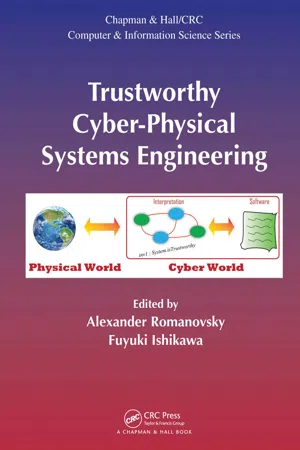
Trustworthy Cyber-Physical Systems Engineering
- 462 pages
- English
- ePUB (mobile friendly)
- Available on iOS & Android
Trustworthy Cyber-Physical Systems Engineering
About this book
From the Foreword
"Getting CPS dependability right is essential to forming a solid foundation for a world that increasingly depends on such systems. This book represents the cutting edge of what we know about rigorous ways to ensure that our CPS designs are trustworthy. I recommend it to anyone who wants to get a deep look at these concepts that will form a cornerstone for future CPS designs."
--Phil Koopman, Carnegie Mellon University, Pittsburgh, Pennsylvania, USA
Trustworthy Cyber-Physical Systems Engineering provides practitioners and researchers with a comprehensive introduction to the area of trustworthy Cyber Physical Systems (CPS) engineering. Topics in this book cover questions such as
- What does having a trustworthy CPS actually mean for something as pervasive as a global-scale CPS?
- How does CPS trustworthiness map onto existing knowledge, and where do we need to know more?
- How can we mathematically prove timeliness, correctness, and other essential properties for systems that may be adaptive and even self-healing?
- How can we better represent the physical reality underlying real-world numeric quantities in the computing system?
- How can we establish, reason about, and ensure trust between CPS components that are designed, installed, maintained, and operated by different organizations, and which may never have really been intended to work together?
Featuring contributions from leading international experts, the book contains sixteen self-contained chapters that analyze the challenges in developing trustworthy CPS, and identify important issues in developing engineering methods for CPS.
The book addresses various issues contributing to trustworthiness complemented by contributions on TCSP roadmapping, taxonomy, and standardization, as well as experience in deploying advanced system engineering methods in industry. Specific approaches to ensuring trustworthiness, namely, proof and refinement, are covered, as well as engineering methods for dealing with hybrid aspects.
Frequently asked questions
- Essential is ideal for learners and professionals who enjoy exploring a wide range of subjects. Access the Essential Library with 800,000+ trusted titles and best-sellers across business, personal growth, and the humanities. Includes unlimited reading time and Standard Read Aloud voice.
- Complete: Perfect for advanced learners and researchers needing full, unrestricted access. Unlock 1.4M+ books across hundreds of subjects, including academic and specialized titles. The Complete Plan also includes advanced features like Premium Read Aloud and Research Assistant.
Please note we cannot support devices running on iOS 13 and Android 7 or earlier. Learn more about using the app.
Information
CHAPTER 1
Concepts of Dependable
Cyber-Physical Systems
Engineering
Model-Based Approaches
CONTENTS
- 1.1 Introduction
- 1.2 Definitions and Concept Bases of CPS
- 1.3 Types of System
- 1.3.1 Defining Cyber-Physical Systems
- 1.3.2 Systems of Systems
- 1.3.3 Embedded Systems
- 1.3.4 Some Properties of CPS
- 1.4 Dependability
- 1.4.1 Achieving Dependability
- 1.4.2 Fault Tolerance in a CPS
- 1.4.3 Security in a CPS
- 1.5 Modeling and Simulation
- 1.5.1 CPS Architectural Modeling
- 1.5.2 CPS Behavior Modeling
- 1.5.3 Real-Time Concepts
- 1.5.4 Modeling Complete Heterogeneous Systems
- 1.5.5 Modeling and Simulation for Validation and Verification
- 1.5.6 Fault Modeling
- 1.6 Conclusions
- Glossary
- References
1.1 INTRODUCTION
1.2 DEFINITIONS AND CONCEPT BASES OF CPS
1.3 TYPES OF SYSTEM
1.3.1 Defining Cyber-Physical Systems
- “ICT systems (sensing, actuating, computing, communication, etc.) embedded in physical objects, interconnected (including through the Internet) and providing citizens and businesses with a wide range of innovative applications and services” [20].
- “Computation, communication and control components tightly combined with physical processes of different nature, e.g., mechanical, electrical, and chemical. Typically a CPS is defined and understood (evaluated) in a socia...
Table of contents
- Cover
- Half Title
- Title Page
- Copyright Page
- Table of Contents
- Foreword
- Preface
- Acknowledgments
- Editors
- Contributors
- Chapter 1 ■ Concepts of Dependable Cyber-Physical Systems Engineering: Model-Based Approaches
- Chapter 2 ■ Pathways to Dependable Cyber-Physical Systems Engineering
- Chapter 3 ■ A Rigorous Definition of Cyber-Physical Systems
- Chapter 4 ■ A Generic Model for System Substitution
- Chapter 5 ■ Incremental Proof-Based Development for Resilient Distributed Systems
- Chapter 6 ■ Formalizing Goal-Oriented Development of Resilient Cyber-Physical Systems
- Chapter 7 ■ Formal Reasoning about Resilient Cyber-Physical Systems
- Chapter 8 ■ Collaborative Modeling and Simulation for Cyber-Physical Systems
- Chapter 9 ■ Verifying Trustworthy Cyber-Physical Systems Using Closed-Loop Modeling
- Chapter 10 ■ Stop-and-Go Adaptive Cruise Control: A Case Study of Automotive Cyber-Physical Systems
- Chapter 11 ■ Model-Based Analysis of Energy Consumption Behavior
- Chapter 12 ■ A Formal DSL for Multi-Core System Management
- Chapter 13 ■ New Standards for Trustworthy Cyber-Physical Systems
- Chapter 14 ■ Measurement-Based Identification of Infrastructures for Trustworthy Cyber-Physical Systems
- Chapter 15 ■ MDD-Based Design, Configuration, and Monitoring of Resilient Cyber-Physical Systems
- Chapter 16 ■ Education of Scientific Approaches to Trustworthy Systems for Industry: After 10 Years
- Index